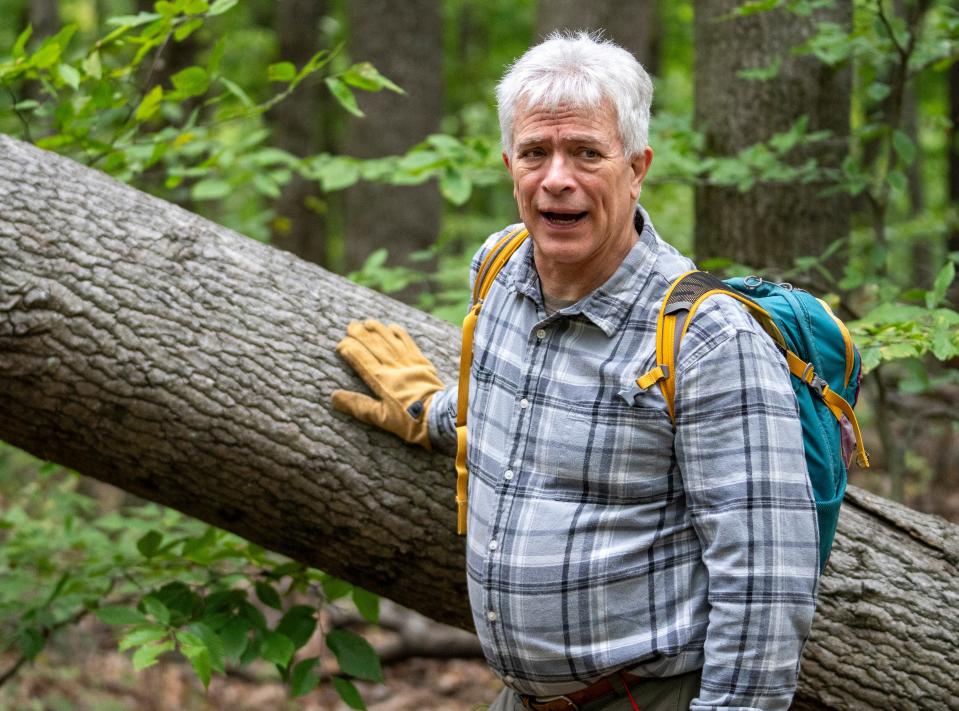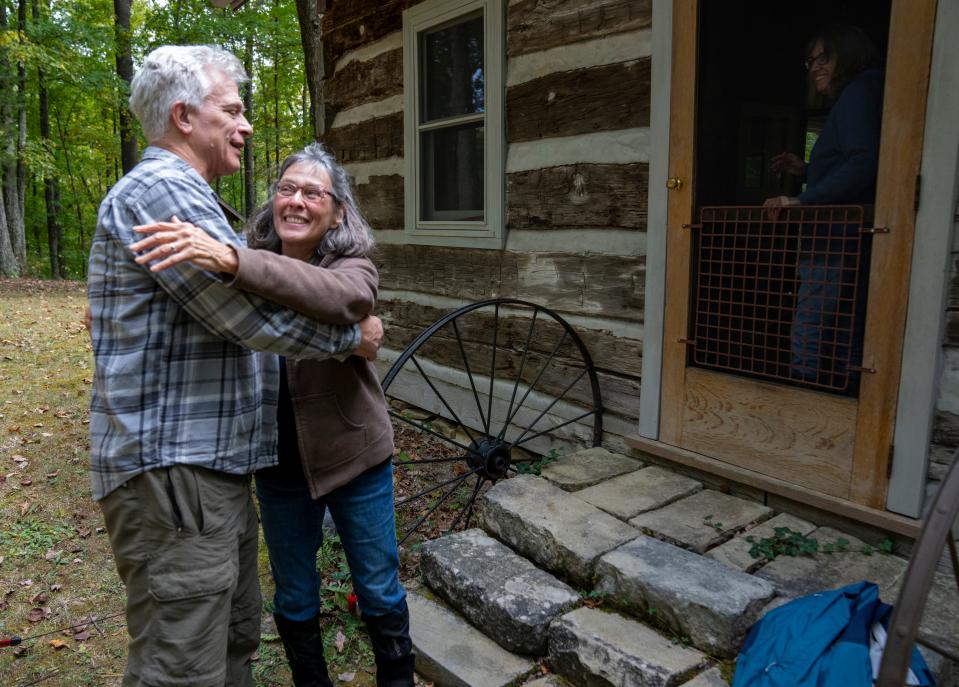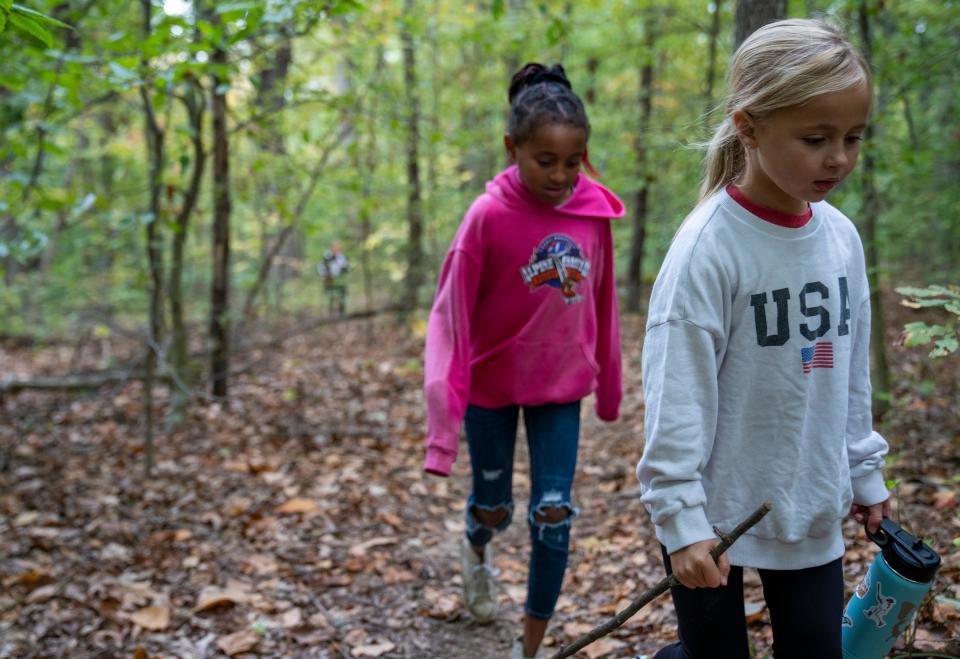Proposal would double size of Charles C. Deam Wilderness area in Hoosier National Forest
- Oops!Something went wrong.Please try again later.
Indiana’s only federally protected wilderness, already one of the largest and most unique natural areas in the Midwest to earn the designation, could more than double in size under new legislation now before the U.S. Senate’s Committee on Agriculture, Nutrition and Forestry.
The bill would expand the Charles C. Deam Wilderness in Monroe and Brown counties to about 28,000 acres, and designate another roughly 30,000 acres of adjacent land for a proposed National Recreation Area. Indiana Senator Mike Braun is sponsoring the legislation.
"(Deam wilderness) is still a unique resource with some blocks of contiguous acreage that would be united," Braun said. "This will take that small gem we have right there in our own state and ... add acres to that because there is not hardly any of it left in the Midwest."
Former U.S. Sen. Richard Lugar oversaw the original wilderness designation, and Braun said that this new proposal will add to that original vision.
"I think he had the right notion then. It's really a unique resource and this is still a small percentage of the Hoosier National Forest, it just puts designations with a little more wilderness area and the new recreation area," Braun said. "That takes what he started to then next level."
The Deam wilderness currently spans 13,000 acres of hardwood forests legally preserved under 1964’s Wilderness Act, which requires land managers to maintain the area’s unimpaired natural condition. Braun’s bill would protect another 15,000 acres.
The federal designation prohibits logging, road construction and other development on public land and is intended to "let nature be nature," according to Jeff Stant, executive director of the Indiana Forest Alliance.
Stant said he’s been talking with Braun since 2013 in a push to get more of the state’s forests set aside and protected from logging efforts.

The conversations eventually culminated in Braun’s recent bill in the U.S. Senate: the Benjamin Harrison National Recreation Area and Wilderness Establishment Act of 2023.
Braun's proposal is not a done deal. The legislation still needs a House sponsor and would have to clear both chambers of Congress and be signed off on by the president to become law.
For now, United States Forest Service spokesperson Marion Mason said the agency has not taken an official position on the proposed bill because it's "too early in the process."
Who was Charles C. Deam?
Charles C. Deam was born a Hoosier and grew up in Bluffton in the second half of the 19th Century. Deam eventually started a drugstore in his hometown and would beat the stress of work by taking nature walks and collecting plants. This led to a passion for botany that opened a path for Deam to become Indiana’s first state forester.
The wilderness area is named in honor of Deam's legacy in botany and love of nature and ties directly to his work getting the Forest Classification Act established in 1921. The act established a framework to help keep the state’s private forests intact.
The current boundaries of the Deam wilderness, which is within the the Hoosier National Forest, begin immediately south of the eastern edge of Monroe Reservoir. It's a mostly contiguous area that stretches south and includes portions of Monroe and Brown.
The expansion under Braun's proposal would be highly segmented, adding new land mostly to the north and east of the current boundaries. A small portion of land north of the reservoir along Axsom Branch Road would also be set aside.
A swath of land to the east of the Axsom Road section, which is owned by the U.S. Army Crops of Engineers, would be excluded from the surrounding wilderness designation. At the eastern edge of the Corps' land, the wilderness would begin again and extend to near the town of Story. The wilderness would then encompass most of the area south until County Road 1000.
Private landowners in Indiana’s wilderness
Stant said he spent a good deal of time working with landowners in the area because he knew there would be opposition if the federal government used eminent domain to create the expanded wilderness and recreation area.
“I had gone all around and talked to them,” Stant said. “Their attitudes were very much, ‘Yeah, if you can keep the federal government out of there, let’s preserve this.’ There was a unanimous amount of support.”
After working with landowners and bringing those private property concerns back to Braun’s team, the senator assured Stant the area should be protected as wilderness.
Janet Selby’s family has owned property near the Deam wilderness for 56 years.
On a crisp fall day in October, Janet along with her two sisters, Susan and Martha, were at the property fixing up a window that needed repair. The family makes trips to the property as often as possible to enjoy the solitude and beauty of undisturbed forest.
Janet recalled that when Deam was initially established in 1982, private property owners were questioning the federal takeover of their lands.

“A lot of neighbors were opposed to that,” Selby said. “In a compromise, they took out a lot of that and in the new bill with Braun, there’s no private property taken, none. That’s one of the good things.”
While Selby said she wished the wilderness bill protected more areas from logging, she’s very happy with the proposed expansion.
“The wilderness is going to protect and maintain current hiking and biking and horse trails in the wilderness,” Selby said. “The access to cemeteries will be maintained just as it is now. Those are all really good points.”
Bill Miller, who has also owned property near Deam since the mid-1960s, was initially opposed to the original wilderness act in the 1980s that would have put limitations on what he could do on his own property.
“We were like ‘No way!’ They didn’t tell us until after they had already submitted the proposal to Congress, which told us they weren’t being fair with the local people,” he said.
It took about 10 years of working with various government bodies before the private landowners like Miller and Selby were satisfied and the Deam wilderness was established.

This time around, Stant has been on the ground working with the local property owners from the beginning and Miller said he’s supporting Braun’s proposal.
“(The forest) belongs to everybody, it doesn’t belong to the state, it belongs to the people of Indiana,” Miller said. “The people of Indiana own it, that’s where the money came to buy it in Depression Era when people could not afford to hang on to farms.”
What’s special about Indiana’s wilderness?
The wilderness designation allows land to be kept forever wild as a reminder of what Indiana was like before it was settled and developed.
“The entire state of Indiana was part of the largest temperate hardwood forest on the planet,” Stant said. “We still have that with this forest, but it’s in danger throughout its range because there aren’t enough areas where we allow nature to take its course and that’s what this wilderness bill would do.”
The current and proposed wilderness areas include a much more diverse ecosystem of trees than found in most other parts of Indiana. Beech and Maple and Poplar trees are free to grow in the wild where the more managed areas are more likely to be a static growth of just Oak and Hickory.
A broader variety of trees and plants also enables a more diverse population of insects and wildlife, Stant said.
“There's a whole movement that says we have to treat the entire state like it's a garden. In other words, there's nothing that can be growing anywhere that we haven't already decided should be there,” Stant said. “To me that impoverishes the world for kids who need to have places like this where they just go and if the oak and hickory is dying out and beach and maples are replacing it, let it happen.”
Keeping land natural is particularly important now in the era of climate change, Stant said. Vegetation zones are shifting and the state needs areas of forest to study what nature is doing under these changes.
“There’s too much of a propensity by land manager to try and play God, to determine winners and losers,” Stant said. “When you do that, you’re basically putting nature in a straight jacket and saying this is how it should be.”
Protecting Indiana forests: Environmental groups remain opposed to Hoosier National Forest management project
What is the National Recreation Area?
Separate from the wilderness expansion, but also included in Braun’s bill, is a proposal to set aside another nearly 30,000 acres of land adjacent to the wilderness for a large recreation area, which allows for more intensive uses. The recreation area would abut the proposed wilderness area to the south and east in Brown County.
Here, mountain bikers can maintain and use trails systems and permanent camp sites can be developed so visitors can enjoy the hilly terrain. Land managers, like the forest service, will be able to create plans for the maintenance of the area, so long as those activities do not threaten the water quality of the Monroe Reservoir.
Braun’s bill would allow the creation of an advisory committee to work with the forest service to develop a new management plan specifically for the National Recreation Area.
What’s next for the wilderness bill?
Braun’s bill is currently at the U.S. Senate’s Committee on Agriculture, Nutrition and Forestry.
The bill still requires a U.S. House sponsor, and Braun said he's been speaking with Congresswoman Erin Houchin.
"My goal is to get it done by the time I leave (office)," Braun said.
Houchin, who represents the district where the wilderness act would protect, said she is still reviewing the legislation and “will be speaking with various stakeholders in the coming weeks.”
Karl Schneider is an IndyStar environment reporter. You can reach him at karl.schneider@indystar.com. Follow him on Twitter @karlstartswithk
IndyStar's environmental reporting project is made possible through the generous support of the nonprofit Nina Mason Pulliam Charitable Trust.
This article originally appeared on Indianapolis Star: Deam Wilderness area would double in size under Sen. Mike Braun bill

